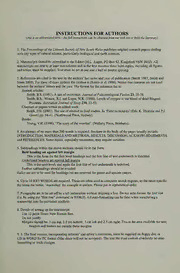
Instructions for Authors PDF
Preview Instructions for Authors
. INSTRUCTIONS FOR AUTHORS {this isanabbreviatedform-thefullinstructionscan beobtainedfrom ourwebsite orfrom theSecretary) 1 TheProceedings oftheLinnean Society ofNew South Wales publishes original research papers dealing with any topic ofnatural science, particularlybiological and earth sciences. 2. Manuscripts shouldbe submitted to the Editor (MX. Augee, PO Box 82, KingsfordNSW 2032). All manuscripts are sentto at leasttwo referees and in the first instance three hard copies, including all figures andtables, mustbe supplied. Textmustbe set at one and ahalfor double spacing. 3. References are cited in the textby the authors' lastname and year ofpublication (Smith 1987, Smith and Jones 2000). Forthree ofmore authors the citation is (Smith et al. 1988). Notice that commas are notused between the authors' names and the year. The format forthe reference list is: Journal articles: A Smith, B.S. (1987). tale ofextinction. JournalofPaleontologicalFiction 23, 35-78. Smith, B.S., Wesson, R.I. and Luger, WK. (1988). Levels ofoxygen in the blood ofdead Ringtail Possums. AustralianJournalofSleep 230, 23-53. Chapters orpapers within an edited work: Ralph, P.H. (2001). The use ofethanol in field studies. In 'Field techniques' (Eds. K. Thurstle andP.J. Green) pp. 34-41. (Northwood Press, Sydney). Books: Young, V.H. (1998). 'The story ofthe wombat'. (Wallaby Press, Brisbane). 4. An abstract ofno more than 200 words is required. Sections in the body ofthe paperusually include: INTRODUCTION, MATERIALSAND METHODS, RESULTS, DISCUSSION,ACKNOWLEDGEMENTS and REFERENCES. Some topics, especially taxonomic, may require variation. 5. Subheadings within the above sections shouldbe inthe form: Bold heading set against left margin This is the form forthe first level headings and the first line oftextunderneath is indented Underlinedheading set against left margin This is the next level, and again the first line oftextunderneath is indented. Further subheadings shouldbe avoided. Italics are notto be used forheadings but are reserved for genus and species names. 6. Up to 10 KEYWORDS are required. These are oftenused in computer search engines, so the more specific the terms the better. 'Australian' for example is useless. Please put in alphabetical order. 7. Paragraphs are to be set offby a tab indentation without skipping a line. Do not auto-format the first line (i.e. byusing the "first line" command in WORD). All auto-formatting can be fatal when transferring a manuscript into the publisherplatform. 8. Details ofsettingup the manuscript: Use 12 point Times New Roman font. Do notjustify Margins shouldbe: 3 cm top, 2.5 cmbottom, 3 cm left and 2.5 cm right. This is the area available fortext; headers and footers are outside these margins. 9. 3. The final version, incorporating referees' and editor's comments, mustbe supplied on floppy disc or CD inWORD forPC format (Mac discs will notbe accepted). The textfile must contain absolutely no auto- formatting ortrack changes. FIGURES: Figures can be line drawings, photographs or computer-generated EXCEL orWORD files. No figures will be accepted larger than 15.5 x 23 cm. Width oflines and sizes ofletters in figures must be large enough to allow reduction to halfpage size. Ifa scale is required, it mustbe presented as abarwithin the figure and its length given in the legend. It is the editor's prerogative to reduce or enlarge figures as necessary and statements such as "natural size" or "4X" in the legend are unacceptable. Photographs must be supplied as black and white prints or as .TIF files (Jpeg is not acceptable) scanned at 600 dpi. Line drawings must be supplied as original copies or as .TIF .files scanned at 1200 dpi. Otherfigures mustbe in hardcopy. While there is no objection to full page size figures, it isjournal policyto have the legend on the same page wheneverpossible and figures shouldnot be so large as to exclude the legend. Figure legends shouldbe placed together on a separate page at the end ofthe manuscript. TABLES Because tables may needto be re-sized, it is essential thattable legends are not set within the table but are supplied separately with the figure legends. Legends need to be the same font and size as the rest of the manuscript. While the text ofthe legend is expectedto be in 12 point type, it maybe necessary to use a smaller font size for large tables. It isjournal policy to accept tables that run over more than one page only in exceptional circumstances. Do not use vertical lines in tables unless absolutely necessary to demark data columns. Keep horizontal lines to a minimum andneverput a border around tables. WORD EXCEL EXCEL or tables are acceptable, but is preferred. Tables and/orfigures must be separate from the text file. Never embed figures or tables in the text. 10. Details ofpunctuation, scientific nomenclature, etc. are to be found in the complete instructions available fi-om the website or from the Secretary. 260
